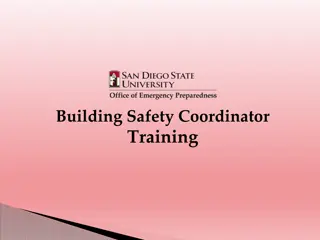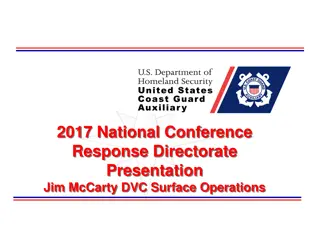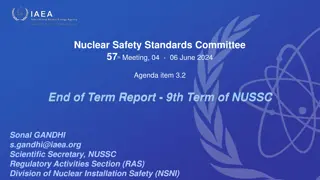Essential Forklift Safety and Competency Guidelines
Comprehensive workplace assessment and competency guidelines for forklift operators, covering essential topics such as forklift safety, driver competency, spotters' roles, barriers and cordons, fitting for purpose considerations, and peer review elements including relevant questions. The guidelines emphasize adherence to safety protocols, efficient maneuvering techniques, load preparation, hazard identification, and peer reflection for continuous improvement in forklift operations.
Download Presentation

Please find below an Image/Link to download the presentation.
The content on the website is provided AS IS for your information and personal use only. It may not be sold, licensed, or shared on other websites without obtaining consent from the author.If you encounter any issues during the download, it is possible that the publisher has removed the file from their server.
You are allowed to download the files provided on this website for personal or commercial use, subject to the condition that they are used lawfully. All files are the property of their respective owners.
The content on the website is provided AS IS for your information and personal use only. It may not be sold, licensed, or shared on other websites without obtaining consent from the author.
E N D
Presentation Transcript
Driver Competency
Workplace Assessment of Competency Effective pre-start checks. Interpreting forklift load charts. Refueling/charging. Safe maneuvering. Load preparation. Identifying route & associated hazards. This Photo by Unknown Author is licensed under CC BY-ND
Workplace Assessment of Competency Continued. Ability to calculate bridging plate max loads (Workplace specific) Compliance with workplace speed limits. Safe accessing/exiting of plant. Ability to correctly fit designed/ approved accessories. This Photo by Unknown Author is licensed under CC BY-ND
Spotters Spotters need to be competent in identifying the following: Load stability Hazardous infrastructure/equipment Pedestrians/vehicles/mobile plant risks Obscured vision of driver Stacking/unstacking pallet risks. Ensuring loads fit along intended route. Boom strike risks along the intended route. Unstable/uneven surfaces. This Photo by Unknown Author is licensed under CC BY-ND
Barriers/Cordons When cordoning areas, consider: Impact on other vehicle/Pedestrian movement. Visibility. Appropriateness of cordons/barriers. Load widths/shape.
Fit for Purpose Forklifts need to be appropriate for the working environment. Forklift selection considerations: Ventilation. Ground/surface conditions. Load weights/widths. Visibility. Lifting heights. Overhead obstacles/restrictions.
Peer Review - Elements The purpose of the peer review is for a Forklift Driver to observe, check and comment on the performance of one of their peers operating a forklift as a means of reflection. Self-review should take place during and after this observation to determine self-performance and opportunities for improvement to driver behaviour. Reference to the relevant company standards should be undertaken.
Peer Review - Questions Has the pre-start check been completed? Is the operator looking behind them when reversing? Is the forklift moving within the site speed limit? When carrying a load, are the forks tilted back? Is any separate component of the load sitting above the mast, unsecured? Does the driver appear aware of pedestrians? Does the driver check the rear of the forklift when turning? Does the driver check the forks of the forklift when turning? Is the forklift parked in the correct position when stationary? Is the load secure / safe? Is the load left in a safe position or state when unloaded? Is the forklift horn being used when necessary? Does the operator enter and exit the forklift safely? Does the driver brake suddenly, creating risk? Is the driver stacking loads according to a Standard? Is the forklift load being carried at the correct height from the ground? Does the driver appear aware of overhead risks Are they looking?
Key Considerations for the Observer: 1. When I am doing the task being observed, how do I drive the Forklift? 2. Are there things that this driver does that I do, positive or negative? 3. Where could I improve as a Forklift driver? 4. Are there any actions we do as common practice that are dangerous and need to change? This Photo by Unknown Author is licensed under CC BY
Safe Forklift Operation Manual https://besafe.nz/safe-forklift-operation-manual/
Helpful links https://www.worksafe.govt.nz/dmsdocument/215-acop-training-operators-and- instructors-of-powered-industrial-lift-trucks https://worksafe.govt.nz/about-us/news-and-media/safety-in-hardware-supplier- yards https://worksafe.govt.nz/about-us/news-and-media/media-release-fatal-interactions- between-forklifts-and-people https://worksafe.govt.nz/topic-and-industry/machinery/forklifts/controlling-the-risk- of-carbon-monoxide-poisoning/forklifts-and-carbon-monoxide https://worksafe.govt.nz/about-us/news-and-media/critical-to-address-the-risks- from-forklifts https://worksafe.govt.nz/about-us/news-and-media/forklift-incident-a-reminder-for- companies-to-learn-from-their-mistakes This Photo by Unknown Author is licensed under CC BY-SA-NC
Thank you Q & A























